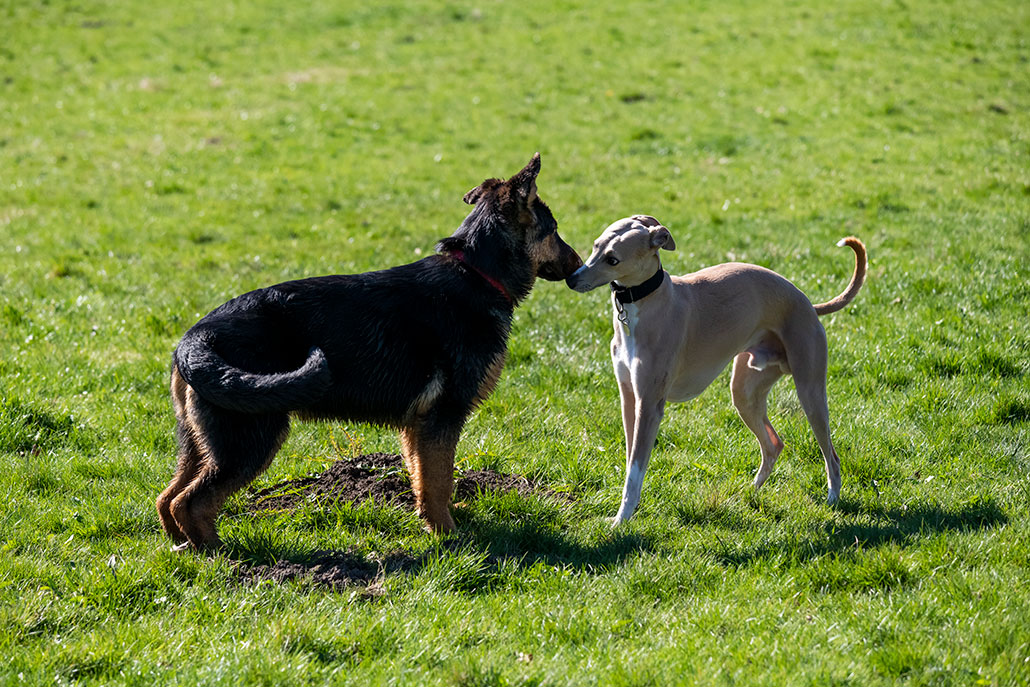Scientists still aren’t always sure why dogs wag their tails
They know what some wags mean, but a lot remains unknown about this common behavior

A happy dog wags its tail, right? Maybe — but it’s more complex than that.
RichLegg/E+/Getty Images
By Jude Coleman
Many people think that if a dog wags its tail, it’s happy. But that might not always be true. Indeed, questions about tail wagging still hound researchers.
Domesticated dogs (Canis familiaris) use their tails to communicate.
Scientists have learned what some types of wags mean. But we don’t know why dogs seem to wag more than other canines. We also don’t know how much of it is under their control. Learning more about how and why a dog wags its tail could help us learn not just about dogs, but about humans.
A dog wagging its tail is one of the most common animal behaviors people see, says Silvia Leonetti. “But a lot of dog behavior remains a scientific enigma,” she says — a puzzle. Leonetti is an ethologist — someone who studies animal behavior — at the University of Turin in Italy. She studied tail wagging while in Nijmegen, the Netherlands. At the time, she was working for the Max Planck Institute for Psycholinguistics. That’s the study of language and the brain.
Leonetti and her colleagues had read studies about tail wagging. From these, they tried to figure out what parts of wagging are not understood. They also hypothesized about the origins of this behavior. Perhaps tail wagging placates some human need for rhythm, they suggested. Or maybe the behavior goes along with other traits humans bred into dogs — like friendliness toward humans or curly tails.
Leonetti and her team put their findings and questions in a new review of scientific studies. They published it January 17 in the journal Biology Letters.
Do you have a science question? We can help!
Submit your question here, and we might answer it an upcoming issue of Science News Explores
The tales tails tell
“People think wagging tail equals happy dog. But it’s actually a lot more complicated than that,” says Emily Bray. She’s an expert in canine cognition at the University of Arizona in Tucson. She did not take part in the study. Learning why dogs wag their tails is important partly from an animal-welfare point of view, she says. It could help dog owners better read their pups’ cues.
One main thing that researchers know, Leonetti and her colleagues note: Dogs wag to communicate. In contrast, whales use their tails for locomotion. Horses use their tails to swat bugs.
Wagging also means different things depending on how the tail wags.
For instance, a dog might wag its tail more to the right side. That typically means the dog is interested or wants to approach something, the researchers note. A wag more to the left could signal uncertainty, or mean the dog wants to back away. A wag low and near the legs is a sign of submission or fear.

Other dogs can understand and react to these different wags.
For something so common, though, there’s a lot scientists don’t know. It’s not clear how much dogs control their own wags. Does the dog even know that its tail is wagging? Can it choose to wag more to the right or left? Several studies have also reported that dogs wag their tails more than other canines, such as wolves. But none have pointed to why this might be true.
It could be related to rhythm, Leonetti’s group says. Side-to-side wags are very rhythmic. The human brain responds well to rhythm. So people might prefer dogs that wag more — even if they are aware of it, the scientists say. Over time, people might have bred dogs to wag more.
Another hypothesis is called domestication syndrome. This is the idea that behaviors and physical traits are linked together in an animal’s genes. So when people breed animals for specific behaviors, other traits might tag along. Perhaps people bred dogs for friendliness or following orders — and tail wagging just came along for the ride.
Tom Reimchen isn’t so sure about either hypothesis. As an evolutionary biologist, he studies how species change and adapt over time. He works at the University of Victoria in British Columbia, Canada. Reimchen isn’t convinced that domestic dogs actually wag their tails more than other canines do. This needs more research, he says, especially in non-domestic species.
Studying different aspects of wagging could point to answers, says Leonetti. Some clues might come from studies of the brain and how animals think. Others might come from learning how dogs’ tails work and move. Plus, domestication involved both humans and dogs. So studying dogs’ wagging behavior could reveal something about people, too.







